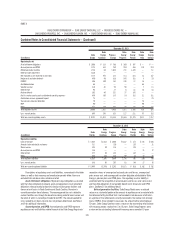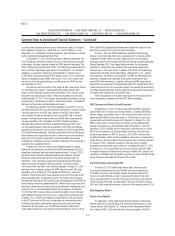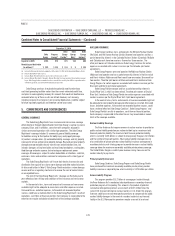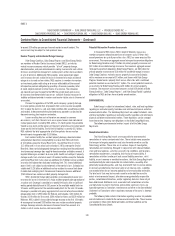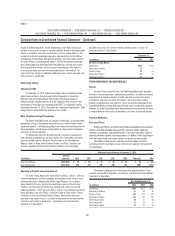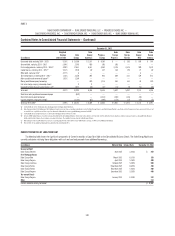Duke Energy 2014 Annual Report Download - page 148
Download and view the complete annual report
Please find page 148 of the 2014 Duke Energy annual report below. You can navigate through the pages in the report by either clicking on the pages listed below, or by using the keyword search tool below to find specific information within the annual report.
128
PART II
DUKE ENERGY CORPORATION • DUKE ENERGY CAROLINAS, LLC • PROGRESS ENERGY, INC. •
DUKE ENERGY PROGRESS, INC. • DUKE ENERGY FLORIDA, INC. • DUKE ENERGY OHIO, INC. • DUKE ENERGY INDIANA, INC.
Combined Notes to Consolidated Financial Statements – (Continued)
designed to meet the needs identifi ed in requests for proposals by Duke Energy
Carolinas, Duke Energy Progress and Piedmont Natural Gas. Dominion will build
and operate the ACP and will own 45 percent. Duke Energy will own 40 percent
of the pipeline through its Commercial Power segment. The remaining share will
be owned by Piedmont Natural Gas and AGL Resources. Duke Energy Carolinas
and Duke Energy Progress will be customers of the pipeline and enter into
20-year transportation capacity contracts with ACP, subject to state regulatory
approval. In October 2014, the NCUC and PSCSC approved the Duke Energy
Carolinas and Duke Energy Progress requests to enter into certain affi liate
agreements, pay compensation to ACP and to grant a waiver of certain Code
of Conduct provisions relating to contractual and jurisdictional matters. The
project will require FERC approval, which the joint venture will seek to secure by
summer 2016. The estimated in-service date of the pipeline is late 2018.
East Bend Station
On December 30, 2014, Duke Energy Ohio acquired The Dayton Power and
Light Company’s 31 percent interest in East Bend Station for approximately $12.4
million. The purchase price has been refl ected in the accompanying fi nancial
statements with the net purchase amount as an increase to property, plant
and equipment in accordance with FERC guidelines. Duke Energy Ohio expects
FERC approval to present the property, plant and equipment and accumulated
depreciation at The Dayton Power and Light Company’s historical cost.
NC WARN FERC Complaint
On December 16, 2014, NC WARN fi led a complaint with the FERC against
Duke Energy Carolinas and Duke Energy Progress that alleged Duke Energy
Carolinas and Duke Energy Progress manipulated the electricity market by
constructing costly and unneeded generation facilities leading to unjust and
unreasonable rates; Duke Energy Carolinas and Duke Energy Progress failed
to comply with Order 1000 by not effectively connecting their transmission
systems with neighboring utilities which also have excess capacity; the plans
of Duke Energy Carolinas and Duke Energy Progress for unrealistic future
growth leads to unnecessary and expensive generating plants; FERC should
investigate the practices of Duke Energy Carolinas and Duke Energy Progress
and the potential benefi ts of having them enter into a regional transmission
organization; and FERC should force Duke Energy Carolinas and Duke Energy
Progress to purchase power from other utilities rather than construct wasteful
and redundant power plants. A copy of the complaint was fi led with the PSCSC
on January 6, 2015. Duke Energy Carolinas and Duke Energy Progress have
fi led a responses requesting dismissal of the complaint with the FERC and the
PSCSC. Duke Energy Carolinas and Duke Energy Progress cannot predict the
outcome of these proceedings.
Merger Appeals
On January 9, 2013, the City of Orangeburg and NC WARN appealed the
NCUC’s approval of the merger between Duke Energy and Progress Energy.
On April 29, 2013, the NCUC granted Duke Energy’s motion to dismiss certain
exceptions contained in NC WARN’s appeal.
On March 4, 2014, the Court of Appeals issued an opinion affi rming the
NCUC’s approval of the merger. On April 8, 2014, NC WARN fi led a petition
for discretionary review by the North Carolina Supreme Court. On April 21,
2014, Duke Energy and the Public Staff jointly fi led their response opposing NC
WARN’s petition. The City of Orangeburg did not fi le a petition for discretionary
review. On December 19, 2014, the North Carolina Supreme Court denied NC
WARN’s petition, concluding the appeal.
Progress Energy Merger FERC Mitigation
In June 2012, the FERC approved the merger with Progress Energy,
including Duke Energy and Progress Energy’s revised market power mitigation
plan, the Joint Dispatch Agreement (JDA) and the joint Open Access
Transmission Tariff. Several intervenors fi led requests for rehearing challenging
various aspects of the FERC approval. On October 29, 2014, FERC denied all of
the requests for rehearing.
The revised market power mitigation plan provided for the acceleration
of one transmission project and the completion of seven other transmission
projects (Long-Term FERC Mitigation) and interim fi rm power sale agreements
during the completion of the transmission projects (Interim FERC Mitigation).
The Long-Term FERC Mitigation was expected to increase power imported into
the Duke Energy Carolinas and Duke Energy Progress service areas and enhance
competitive power supply options in the service areas. All of these projects were
completed in or before 2014. On May 30, 2014, the Independent Monitor fi led
with FERC a fi nal report stating that the Long-Term FERC Mitigation is complete.
Therefore, Duke Energy Carolinas’ and Duke Energy Progress’ obligations
associated with the Interim FERC Mitigation have terminated. In the second
quarter of 2014, Duke Energy Progress recorded an $18 million partial reversal
of an impairment recorded in the third quarter of 2012. This reversal adjusts the
initial disallowance from the Long-Term FERC mitigation and refl ects updated
information on the construction costs and in-service dates of the transmission
projects.
Following the closing of the merger, outside counsel reviewed Duke
Energy’s mitigation plan and discovered a technical error in the calculations.
On December 6, 2013, Duke Energy submitted a fi ling to the FERC disclosing
the error and arguing that no additional mitigation is necessary. The City of
New Bern fi led a protest and requested that FERC order additional mitigation.
On October 29, 2014, FERC ordered that the amount of the stub mitigation
be increased from 25 MW to 129 MW. The stub mitigation is Duke Energy’s
commitment to set aside for third parties a certain quantity of fi rm transmission
capacity from Duke Energy Carolinas to Duke Energy Progress during summer
off-peak hours. FERC also ordered that Duke Energy operate certain phase
shifters to create additional import capability and that such operation be
monitored by an independent monitor. Duke Energy does not expect the costs to
comply with this order to be material. FERC also referred Duke Energy’s failure
to expressly designate the phase shifter reactivation as a mitigation project in
Duke Energy’s original mitigation plan fi ling in March 2012 to the FERC Offi ce of
Enforcement for further inquiry. Duke Energy cannot predict the outcome of this
additional inquiry.
Planned and Potential Coal Plant Retirements
The Subsidiary Registrants periodically fi le Integrated Resource Plans
(IRP) with state regulatory commissions. The IRPs provide a view of forecasted
energy needs over a long term (10 to 20 years) and options being considered
to meet those needs. Recent IRPs fi led by the Subsidiary Registrants included
planning assumptions to potentially retire certain coal-fi red generating facilities
in Florida, Ohio and Indiana earlier than their current estimated useful lives.
These facilities do not have the requisite emission control equipment, primarily
to meet EPA regulations recently approved or proposed.
The table below contains the net carrying value of generating facilities
planned for early retirement or being evaluated for potential retirement
included in Net property, plant and equipment on the Consolidated Balance
Sheets, excluding the Duke Energy Carolinas 170 MW Lee Unit 3 which is being
converted to gas in 2015.




